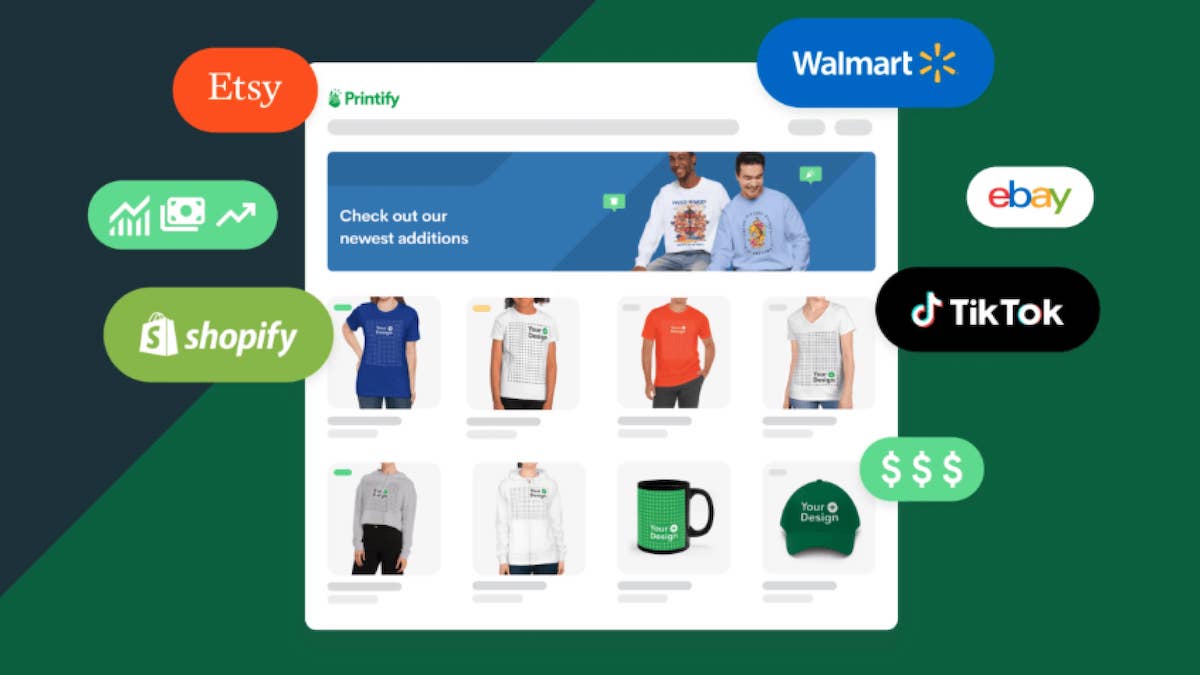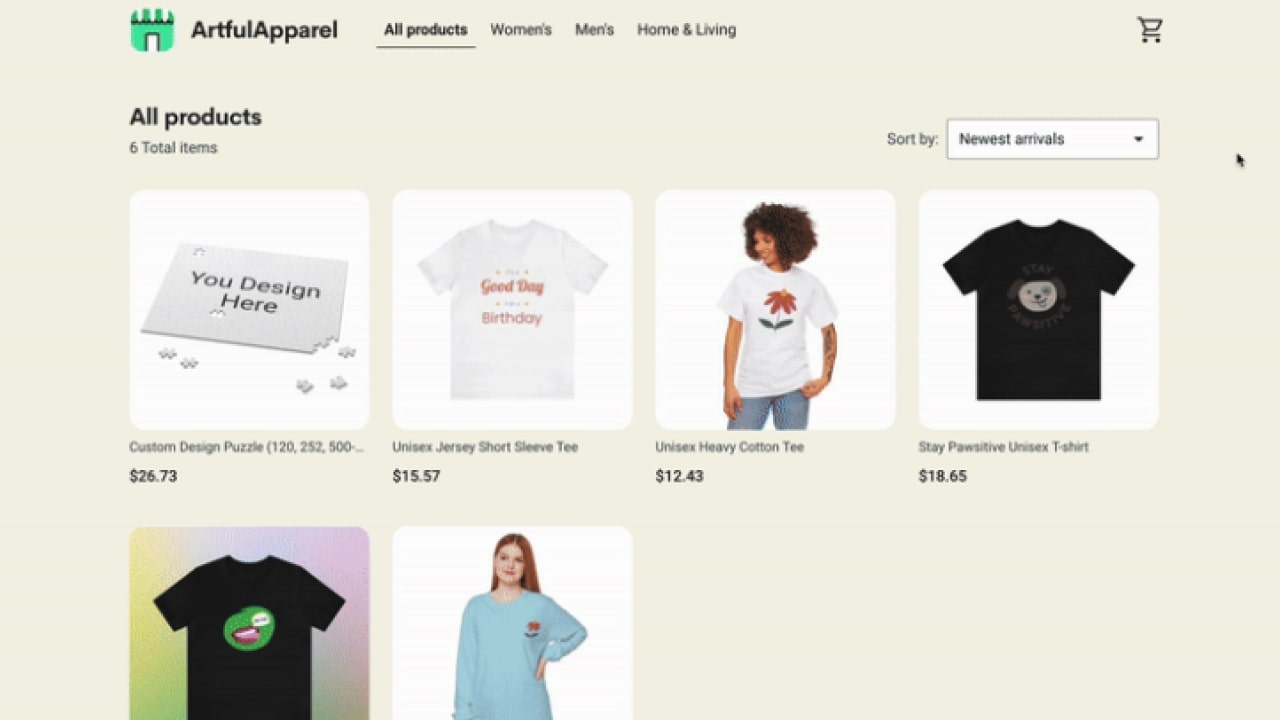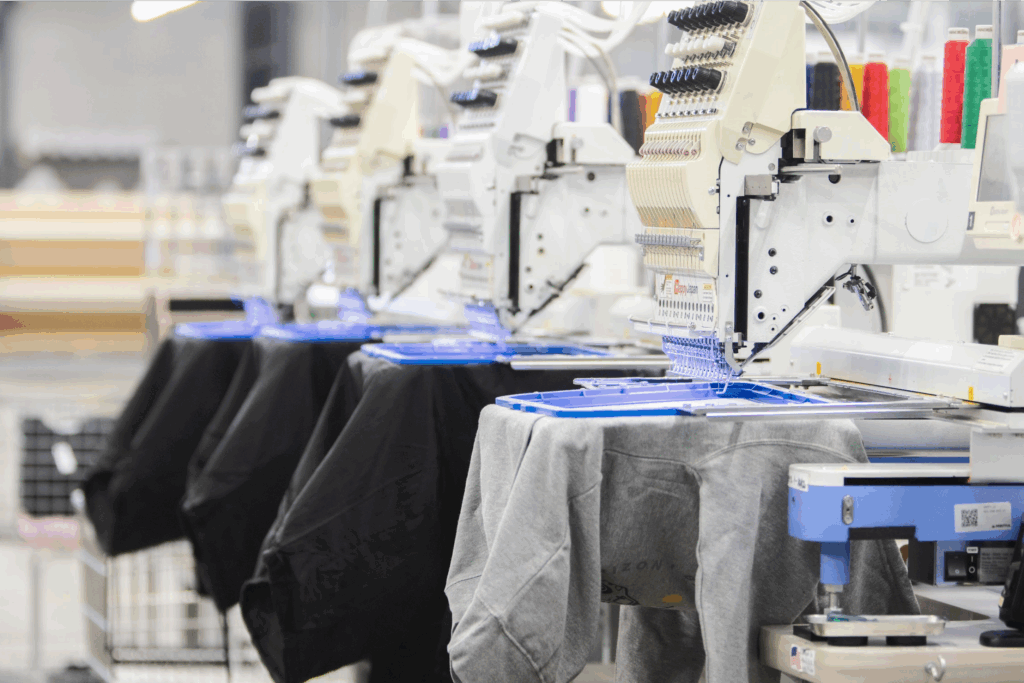Start a custom printing business with Printify
If your 9-to-5 has become tiresome, and you dream of financial freedom, starting an online store could be the answer.
In 2024, worldwide retail eCommerce sales are projected to reach $6.9 trillion, highlighting the industry’s immense potential.
Today, you can start your own online business without initial investment, inventory, or in-depth entrepreneurial knowledge. There are plenty of business models that can help you get started.
In this guide, we show you how to start an online store with no money by covering everything you need for success – from choosing a business model and niche to sourcing, designing, and marketing products.
This post may contain affiliate links, which means we may earn a commission if you make a purchase through those links. This comes at no additional cost to you.
Business models for starting an online store with no money
When starting an online store, finding the right business model is vital, especially if you don’t have the startup capital to invest. Thankfully, the eCommerce industry provides various options, which we explore below.
While each is a bit different, every one of them is worth considering and can help you make money online.
Print on Demand
![Print On Demand Profit Calculator How to start an online store with no money in [bp_year] 1](https://printify.com/wp-content/uploads/2024/01/Print-On-Demand-Profit-Calculator.jpg)
Print on Demand (POD) is a beginner-friendly order fulfillment method that lets you design, create, and sell custom products, from apparel and accessories to pet items and print-on-demand cosmetics. The best part? There is no need to worry about inventory, storage, or logistics.
Here’s a quick overview of how Print on Demand works:
- Sign up with a POD supplier like Printify.
- Choose a product to sell – from custom phone cases to apparel, stationery, or kitchen accessories.
- Apply your custom design to the product using our free Product Creator (formerly known as Mockup Generator).
- Select your sales channel, such as an eCommerce platform or marketplace.
- Add products to your online store and start selling.
- When a customer orders from your store, the POD supplier takes care of the rest – sourcing, printing, packaging, and shipping directly to your customer.
Print on Demand keeps startup costs low, making it easier for entrepreneurs to launch their businesses. However, eCommerce platforms or marketplaces may charge various fees, and some optional marketing methods will cost you.
Industry experts project that the global print-on-demand market size will reach $38.21 billion by 2030, presenting an exciting opportunity for anyone looking to start their own business. Whether you’re interested in custom-printed hoodies, drinkware, or even beauty products, the potential is limitless!
Industry’s data: Experts forecast that the global print-on-demand market size will reach $38.21 billion in 2030.
Dropshipping

While similar to Print on Demand, dropshipping is slightly different – you can’t customize the products you sell. Otherwise, similar principles apply, allowing you to sell a wide variety of products without holding inventory or worrying about logistics.
Typically, this is how dropshipping works:
- Step 1: Agree with a supplier on prices, rates, and list products on your store.
- Step 2: A customer purchases your product.
- Step 3: You or the automated system forwards the information to the supplier.
- Step 4: The dropshipping supplier sources or produces, packages, and sends the product to the buyer.
You pay the wholesale price, and the customers pay the price you set. In other words, you simply sell the supplier’s products and take a cut for yourself.
Industry’s data: It’s estimated that the global dropshipping market size will reach $476.1 billion in 2026.
Third-party fulfillment centers

If you already have products to sell but want to skip out on logistics and the cost of warehousing, partner with a third-party fulfillment center.
For example, companies like ShipHero or Red Stag Fulfillment can connect with an eCommerce website and handle warehousing, packaging, and shipping.
While the process can vary depending on the company and services you need, it typically looks like this:
- Step 1: You contact the fulfillment center, negotiate rates (some may offer a pay-as-you-go model), and send the inventory to them.
- Step 2: After a customer places an order on your eCommerce website, the order, either manually or automatically, is forwarded to the fulfillment center.
- Step 3: The warehouse team picks and packs the product and adds the order receipt and details.
- Step 4: The shipping carrier collects the order from the fulfillment center and delivers it to your customer.
Whichever of these three business models you choose, thoroughly vet the companies to avoid trouble – talk to their representatives, examine their websites, and read third-party reviews.
Quick tips
Apart from selling physical products, you can sell services and digital products, too. Learn more about how to start a business with no money in 2025.
Another great way to make money is by joining an affiliate marketing program – companies pay a certain percentage as an affiliate fee for every purchase via your affiliate link. With the Printify Affiliate program, enjoy a 5% commission from each sale your referrals make.
Need more options? Learn how to start an online store without inventory using other business models.
Make it happen today!
How to start an online store for free: 10 easy steps
With a bit of patience, anyone can enter the world of eCommerce, start their own business, and make money online. Here’s a thorough guide.
1. Select a niche

A niche refers to a specialized market segment for a particular product. With the right niche, you can attract customers, enjoy less competition, and increase profits.
If a niche market is too broad, it won’t resonate with people. If it’s too narrow, finding customers may be challenging. A small business should aim for a healthy balance.
You can find a trending niche with quick market research.
- Identify trends. Facebook, Instagram, and X provide valuable insights into customer preferences.
- Use market research tools. Try Semrush or BuzzSumo to see if your ideas are popular enough to build a business around them.
Quick tips
To learn more, our article – What Is a Niche? – provides a 101 on everything you need to know.
Explore the top 15 print-on-demand niches for 2025.
If you favor the dropshipping business model, check out the best dropshipping niches.
2. Identify profitable products
When starting an online business, making a collection of products potential customers will gladly buy is essential.
Here’s how to find the best-selling items for a business.
- Try product research tools. Sell The Trend and Niche Scraper are great for identifying products that are in high demand.
- Analyze competition. Research other businesses, their product collections, and customer reviews. Analyze this information to identify and sell products that are similar but better.
- Use marketplace search bars. For example, when using the search bar of Etsy or Amazon, you’ll get suggestions after typing only a few letters. Type in a niche and a list of products will appear in a drop-down window.
Quick tip
Take a look at other dropshipping product research tools to find the one that best fits your business needs, or explore the top 35 best-selling print-on-demand dropshipping products.
3. Find a reliable supplier

While there are many dropshipping websites and suppliers, they’re each different, so research and vet them carefully.
Here’s what you should pay attention to:
- Supplier’s reputation. Search for their existing merchant reviews and check whether they have good ratings.
- Location. If possible, choose a local business to guarantee quick delivery and reduce the cost of shipping.
- Quality and selection. A good supplier provides high-quality wholesale products at a reasonable cost. Order samples to make sure they meet your standards.
- Turnaround time. Ask – better yet, test – their turnaround time and check whether they can meet your requirements without delays.
Don’t trust a supplier without confirming that they’re a real and reliable company – get in touch with them, read verified reviews, and go through search results.
Quick tips
In Printify’s print-on-demand dropshipping supplier database, you can access over 80 thoroughly vetted Print Providers.
4. Create product designs
If your focus is solely on dropshipping, you can skip this step. However, if you go with the print-on-demand business model, here’s how to create original product designs.
Start by exploring sites like Dribbble, Pinterest, and Behance to gain inspiration and understand what’s trending.
Then, use tools like the Printify Product Creator, Canva, or GIMP to create a design.
With our beginner-friendly Product Creator, you don’t need to be a professional designer to create your own designs. Easily upload graphics, images, logos, or create original designs from scratch with the help of our AI Image Generator, Text Editor, and free Graphics Library.
Quick tips
If you have a great idea for a design but don’t have the patience to create it yourself, hire a freelancer from the Printify Experts Program, Fiverr, or Upwork.
Keep your small business out of legal trouble by learning how to avoid copyright infringement.
5. Establish a brand

Good branding sets a business apart from the competition. If you build a brand that resonates with your target audience, captivating their attention and developing an emotional connection is easier.
Firstly, come up with a business name. Three hallmarks of a great business name are simplicity, originality, and memorability.
Then, consider the following aspects:
- Vision. What’s the mission of your business? Tell customers your story and motivation for starting an online boutique. Why should they trust you?
- Values. What do you stand for? Animal rights? Environmental protection? If your customers share the same values, it’ll be easier to gain their trust.
- Voice. Tailor your tone of voice so that it appeals to your target audience. Use it consistently across all channels.
- Visuals. Design visual assets (like a logo, illustrations, icons) in a consistent color scheme highlighting your brand’s personality. Try Pixlr or Adobe Express to get started.
6. Register your business
Each country, state, and city has different rules and regulations, so it’s important to understand the legal requirements in your jurisdiction.
Disclaimer
Intended for informational purposes. To prevent any confusion and legal issues, we highly advise consulting a qualified legal professional who can provide guidance tailored to your business needs.
Firstly, evaluate various business structures to find the right one.
Then, go to the U.S. Small Business Administration’s website and check their guide on registering a business. While registering isn’t always necessary for small businesses, without doing so, you could miss out on personal liability protection as well as legal and tax benefits.
In some cases, you might need a business license or a permit. You can learn how to get a business license from our article.
7. Choose where to sell

When learning how to start an online store with no money, it’s important to choose the right sales channel. Whether you want to open an online store on an eCommerce platform or a marketplace, both have their own features, capabilities, and limitations you need to consider.
eCommerce platforms
With eCommerce platforms, you can build a visually appealing store without the help of a website designer. They have drag-and-drop features for designing, pre-made templates, various payment processor options, and professional themes that streamline the whole process.
Advantages:
- Seamless personalization
- Customer retargeting
- Control over customer data
Disadvantages:
- A store may take time to build
- Higher marketing costs
- Some require technical skills
A few examples:
Quick tips
An even faster and easier way to start selling is by using the Printify Pop-Up Store. We fulfill every order on demand, so there’s no upfront cost to get started. Then, we deliver straight to your customer’s doorstep.
While some eCommerce platforms have a monthly fee, they offer free trials so you can understand whether it’s the right one for your business.
eCommerce marketplaces
With marketplaces, setup is quick and easy – perfect for small businesses just getting started. You simply open a store and list products for sale to an existing customer base. However, due to limited customization, building a brand is much more difficult.
Advantages:
- Easy and quick setup
- Pre-existing traffic
- Beginner-friendly
- Easy maintenance
Disadvantages:
- Less customization, creative control
- Highly competitive
- Strict policies
- Fees
A few examples:
If none of these fit your business needs, but you have coding experience, consider our Printify API. Integrate it into your own website to develop personalized functionality and automate the workflow.
Quick tip
Learn more from our overview of the best sales channels, which explores their features and limitations.
8. Make and list your products

After choosing an eCommerce solution, list the products on your store. Each platform and supplier will have a different procedure.
For example, with Printify’s print-on-demand service, it’s a straightforward process that goes like this:
- Sign up for a free account
- Follow the instructions in our Help Center to connect your store
- Select a product from the Printify Catalog
- Design with our beginner-friendly Product Creator
After a design is ready, click Save product and do the following:
- Select a title image and mockup views to display in your store.
- Choose a title image color. If available, because some products may have only one variant.
- Edit the title.
- Write a description.
- Set or use a suggested price and profit margin.
When all is ready, click Publish to add it to your store.
After you make a sale, our Print Providers will handle all the heavy lifting – printing, packaging, and shipping.
9. Work on search engine optimization
Search engine optimization (SEO) is a way to increase your store’s visibility and ranking in search engines to get more traffic.
Optimize your store by:
- Adding relevant keywords in product titles, descriptions, and elsewhere throughout the store. Find keywords with a research tool like Semrush or Ahrefs.
- Using great product photos with keywords in their meta descriptions.
- Building a mobile-friendly website that loads quickly and has a user-friendly interface.
Quick tip
You can also increase your store’s visibility with paid advertising, like Google Ads.
10. Promote your online store

Without an all-encompassing marketing strategy, new businesses are unlikely to succeed. Try various marketing channels to expand your customer base and get more sales.
- Social media. A free way to advertise. Establish a social media presence on various platforms. Post captivating product photos, offer giveaways, and run contests to drive traffic to your store.
- Content marketing. Another marketing strategy you can start with no money. If you consistently publish relevant content, you can gain your customers’ trust.
Additionally, consider starting a YouTube channel. YouTube videos are a great way to engage with your target audience and showcase your products.
- Email marketing. A popular and cost-effective way to advertise. Try tools like MailerLite or Omnisend that automate the process.
- Paid advertising. Try Facebook, Instagram, TikTok, or Google Ads to promote your business.
Make it happen today!
Why open an online store with Printify?
With Printify’s print-on-demand services, opening an online store is easy. We provide everything you need to design, create, and start selling one-of-a-kind products.
No inventory required
Start an online business without investing in inventory or storage space.
100% Free
Our print-on-demand services are 100% free and accessible to everyone, everywhere.
Beginner-friendly
Anyone can open and run an online store without the complexities of producing, packaging, and shipping products.
Vast product scope
Whatever you’d like to sell, the Printify Catalog has more than 900 products to suit any business needs.
eCommerce integrations
We provide seamless integrations with all the major eCommerce platforms and marketplaces, so you can easily start selling today.
How to make an online store for free: A summary
As we conclude our guide on how to start an online store with no money, we hope you found the information helpful, providing enough inspiration to take the first step.
A brief recap of the steps you should take:
- Select a niche
- Identify profitable products
- Find a reliable supplier
- Create designs
- Establish a brand
- Register your business
- Choose where to sell
- Make and list your products
- Work on SEO
- Promote your online store
While starting a small business requires patience, persistence, and planning, it’s a truly rewarding journey.












